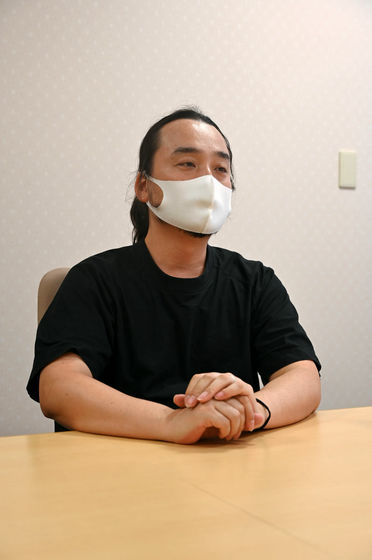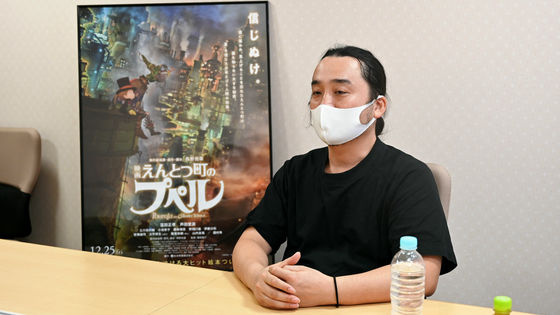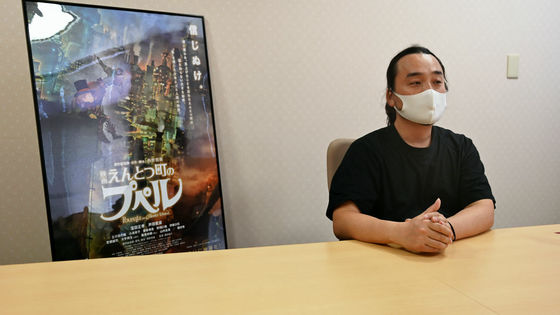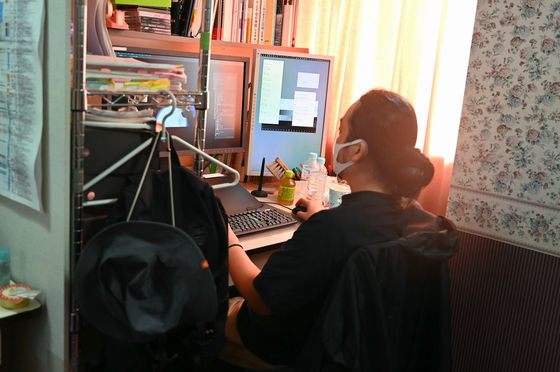Interview with Yuusuke Hirota, director of the animated movie 'Pupelle of Chimney Town'

'Movie Entotsucho Pupel ' based on Akihiro Nishino's picture book was released on December 25, 2020 (Friday) and is showing a big hit. This work was directed by STUDIO 4 ℃ 's grown-up staff, and the feature film was directed by Yusuke Hirota, who is the first to direct this work. I have been asking various questions about how I worked on the work that became an exceptionally big hit as a picture book.
'Movie Entotsucho Pupel' Official Website | A blockbuster screening!
https://poupelle.com/
Director Yuusuke Hirota

GIGAZINE (G):
Director Hirota's first directorial work is this 'Pupelle of Chimney Town'. When did the talk about not supervising come?
Director Yusuke Hirota (hereinafter referred to as Hirota):
I don't remember exactly about the winter of 2017 ... First of all, I was called and asked to show me the picture book of 'Pupelle of Chimney Town' saying 'I have a picture book like this'. I had seen it at a bookstore and knew that it was a picture book by Mr. Nishino from King Kong. I was curious because the cover was very elaborate and the picture was attractive, but I had never actually picked it up and read it.
G:
Hmmmm.
Hirota:
Producer Tanaka asked me, 'Actually, I got an offer and I'm making a movie, but what about as a director?' I had never directed a feature film, but I originally wanted to make a movie. I was thinking, 'Did the story finally come!' However, I didn't know what the story was, so I first read a picture book and said, 'I'll think about it for a moment,' and took some time.
G:
How was it when you actually read 'Pupelle of Chimney Town'?
Hirota:
I was honestly impressed. I also had a child and became a parent, so there was a part that I sympathized with, and it was Jean. I've always wanted to make a work that children can enjoy, so this is a big opportunity for me. However, at that time, 'Pupelle' was just talking about Mr. Nishino's free release of picture books ...
G:
There was a burning feeling.
Hirota:
I was hit from here and there, so I was wondering what was going on. I didn't know what kind of person Mr. Nishino was, and I didn't know what kind of stance he would be involved in as the original author, so I had the image that he was a little scared. I was only looking at such net news articles. So, check and read the blog that Mr. Nishino actually wrote, the business book '

Hirota:
So, with Tanaka's suggestion, 'Let's talk in a face-to-face manner, and if we don't like each other, let's do it,' we set up a place to actually talk.
G:
How was it when you met Mr. Nishino?
Hirota:
When I met him, he had no bad image at all, and he was a person who was very serious about making works and entertainment. I've been saying 'defeat Disney' since then, and I felt that I was seriously working toward it. I was also impressed, I thought it was wonderful, and said, 'I hope we can do it together.' I thought that this could make a wonderful work.
G:
What is Nishino's involvement in the movie?
Hirota:
When I read the picture book of 'Pupelle of Chimney Town', I thought, 'The volume of the movie is still not enough.' When I asked Mr. Nishino about that, he said, 'Actually, there is a bigger story in' Pupelle of Chimney Town. 'The picture book is a part of it.' 'I want to write a movie scenario. Is. ' There was a scenario that Mr. Nishino wrote before drawing the picture book of 'Pupelle of Chimney Town', and he said, 'I want to remake it for the movie this time.' I think it's better to do it. '

Hirota:
It's a little dangerous what kind of time axis it was, but I met Mr. Nishino once every two weeks and devised a scenario for a total of about half a year. Every time I met, Mr. Nishino rewrote the scenario, and while checking it with everyone, he came up with ideas such as 'I think I should do this a little more', and Mr. Nishino rewrote it again. In the end, I repeated up to about 15 drafts and finally drafted.
G:
I heard that the scenario was a considerable amount.
Hirota:
I made it assuming that it was 90 minutes long, and considering that, the number of pages was appropriate, but the amount of dialogue was large. I think this is unique to Mr. Nishino, but when I read the scenario, I thought that 'tempo is very important' because there are quite a few lines in 'Pupelle of Chimney Town'. is. So, in order to make a good tempo, it is necessary to increase the cut split considerably. I wanted to do that kind of production, and thanks to the storyboards I made, it was close to 2000 cuts. I didn't draw the storyboard by myself, but mainly by three people.
G:
In an interview, Mr. Naoya Amada, the producer, answered that there
Hirota:
Yes, that's the number in the end.
G:
What kind of selection did you make from nearly 2000 cuts to 1437 cuts?
Hirota:
I put the storyboard into a video storyboard once, and asked the editor to edit it after consulting with the editor, 'I want to make it an hour and a half instead of two hours.' While looking at it from the editor's point of view, I managed to shorten the length of each cut and cut the entire scene that does not have a big influence on the story, and I managed to put it in about 1400 cuts.
G:
So that's it. Director Hirota says that STUDIO4 ℃ is a grown-up, but why was STUDIO4 ℃ among various animation production companies?
Hirota:
I was studying fluid mechanics at the Faculty of Science and Engineering at the university, but I was confused about getting a job in that direction. I really liked drawing, but I also thought, 'I don't have the ability to eat with pictures.' However, just about 20 years ago, Pixar made ' Toy Story ' with CG, and 'making images with CG' began to appear in the world. So I thought, 'I think I can eat CG,' so I went to Digital Hollywood to study CG. I thought that I could go if I was involved in making pictures using CG or making images.

G:
So that's it. Have you been quite familiar with PCs since you were studying fluid mechanics at university?
Hirota:
I agree. At that time, I was playing with software called 'Hanako ' and software that draws pictures with dots, and I thought it was interesting, so I wanted to challenge the path of CG.
G:
So I went to Digital Hollywood from university and entered STUDIO 4 ℃ from Digital Hollywood.
Hirota:
Yes. I agree.
G:
What kind of company was STUDIO4 ℃ when Director Hirota joined the company?
Hirota:
I joined the company when STUDIO4 ℃ released 'Princess Arite '. Rather than an anime company, I sent my portfolio and video works to a company that uses CG to make cool videos without even checking if I was looking for staff. Among them, STUDIO 4 ℃ was the only animation company.
G:
I see, that was the case. I heard that this work was made under the influence of the new coronavirus, and that the remote was the main one. Please tell us the good points and the troubles of being remote from the director's point of view while actually producing 'Pupel' with 3DCG.
Hirota:
The good thing is that I could save commuting time and work at home at midnight or at any time I like. Even when my wife couldn't see my child, I was able to stay at home with my child, and I think the biggest merit is that I can use my time effectively. Before that, it was a full 3D work, so it was a relief to just exchange data. In the case of drawing, I have to exchange the real thing (picture drawn on paper), so I think that the harmful effect was great.
G:
On the contrary, what was the problem?
Hirota:
I was in trouble because I couldn't check the exact color when it was remote. In-house, we have decided on a monitor called a master monitor, 'let's make it based on the color of this monitor', but if it is remote, the amount of information on the number of colors will decrease, so it is not possible to check the exact color. It was. Also, when I listened to the sound remotely, I heard it late, or it was cut off in the middle, so I was in trouble. It was stressful that I couldn't check like that. The rest is communication.
G:
communication.
Hirota:
It's pretty easy to talk to me inside the company, but when it comes to remote, there should be many means such as Zoom, Skype, and telephone, but there is one hurdle between me and other people, or it takes a stop. I had the impression that I suddenly stopped communicating with other people. When I was in the company, I had a lot of casual discussions, so I was in trouble.
Director Hirota working in-house

G:
Have you taken any precautions from the director to eliminate the difficulty of communication?
Hirota:
I used to talk to him on Skype. I think it's hard for me to hear from other people.
G:
Isn't it the problem of 'because the number of chats has decreased', but is it like something in between?
Hirota:
I agree. It's like that.
G:
So that's it. Certainly, it seems that color and sound problems can be solved technically, but it seems that it will be quite difficult to solve such communication problems any more.
Hirota:
To make up for that, the Telework group had a morning assembly every morning with everyone showing each other's faces and saying, 'Let's do our best today,' and wrote a daily report every day. However, there are also in-house groups that are not telework, and Tanaka and the production progress were in-house groups, so there is a part that inevitably revolves around that, and the telework group is set up with very close communication even with the in-house group alone. There was something like being killed.
G:
So that's it……. From the perspective of the director, who says that he is a grown-up, what is the point that 'this area of STUDIO 4 ℃ is amazing'?
Hirota:
After all, the staff at STUDIO 4 ℃ is a gathering of people who work hard with everyone, or who are purely fond of making works. No one is making a proper work. I was looking at the backs of my seniors who continued to aim for heights until the deadline, so I was also influenced by the fact that such an attitude is important. People around me often say, 'Don't be so particular about it,' but I don't mean to be particular about it at all, and I'm doing it thinking that 'this is a place to do.'

G:
I heard that if the director sticks to the shape of the ear hole of the model, it will not proceed, so I heard that the modeling was entrusted with full authority from the middle, but what is the producer Tanaka who manages the production? Is there a lot of bargaining around those parts?
Hirota:
That's right (laughs) When the direction of the model was decided to some extent, I decided to leave it to the chief I trust. Well, I don't mean to be too particular about it, but I was told that such checks as 'the timing of the camera is different' or 'the line of sight is a little different' are also 'too particular'. Still, I checked all the layouts.
G:
I'm too particular about it.
Hirota:
It simply takes a long time to check, or the production said, 'Give me 40 cuts a day,' and 'that's impossible.'
G:
I see, the point from the production is from a time perspective.
Hirota:
I agree. If the first part takes a long time, the later work will be wrinkled. Before I was the director, I was also in charge of shooting as a CG staff, so I know that the slowness of the director will affect the work afterwards. But when I try it, it takes time (laughs)
G:
What was the point that took time when you actually tried it as a director?
Hirota:
After all, the first thing to think about, such as storyboards and layout, is difficult. I realized that it would take time.
G:
Do you have the image that it takes time to improve the quality?
Hirota:
Of course, I think that the time it takes is largely due to my lack of experience. However, I knew from experience that even if the production said, 'I should fix it later, so I'll raise it more and more', I can't fix it later when I run out of time. I tried to fix it as soon as possible if I had to fix it now.
G:
'That's not possible.'
Hirota:
Yes. After that, when I am making a CG model, I actually move the model with animation, but the first preparation is also very important here. Work efficiency is greatly affected by the initial preparation of bones, how the body is attached to the bones, the silhouette of the model, and so on. Of course, I also take the method of gradually upgrading the model, but I realized that the first preparation is a time-consuming task that I can't get rid of. Especially with CG. In the case of drawing, you can fix only the part you want to fix later, but in the case of CG, you have to overhaul the model just to fix it a little, or if you fix it, the other parts will be affected. On the contrary, it becomes troublesome.
G:
You can draw by hand.
Hirota:
I agree.
G:
While working on the movie 'Pupelle of Chimney Town', I was wondering 'Is this going to work?' Before working on it, but when I actually worked on it, 'I was able to do better than I had imagined. Please tell me the part that says 'Zo'.
Hirota:
It was the first time for me and STUDIO 4 ℃ to make a movie with full 3DCG, but since it is a culmination of my work that I have always wanted to make a movie with full 3DCG, the character's modeling, movement, background, etc. There is a response that the quality of things has become the best ever. Especially for the facial expressions of the characters, I think I was able to do well where the body temperature tends to disappear with CG. The rest is the background. The amount of work here was more than I expected, but as a result it has improved a lot.
G:
So that's it. Thank you for talking with us today.
An interview with the staff of 'Pupelle of Chimney Town', followed by an interview with animation director Yuta Sano.
・ Continued
Interview with Yuta Sano, animation director of 'Pupelle of Chimney Town', which summarizes 'garbage humans' into 'non-human' movements --GIGAZINE

Related Posts:








